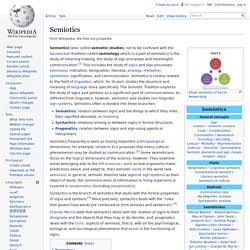

Semiotics. Semiotics frequently is seen as having important anthropological dimensions; for example, Umberto Eco proposes that every cultural phenomenon may be studied as communication.[2] Some semioticians focus on the logical dimensions of the science, however.

They examine areas belonging also to the life sciences – such as how organisms make predictions about, and adapt to, their semiotic niche in the world (see semiosis). In general, semiotic theories take signs or sign systems as their object of study: the communication of information in living organisms is covered in biosemiotics (including zoosemiotics). Semiotics Explaination. 2001: A Space Odyssey (film) Produced and distributed by the U.S. studio Metro-Goldwyn-Mayer, the film was made almost entirely in England, using both the studio facilities of MGM's subsidiary "MGM British" (among the last movies to be shot there before its closure in 1970)[4] and those of Shepperton Studios, mostly because of the availability of much larger sound stages than in the United States.

The film was also coproduced by Kubrick's own "Stanley Kubrick Productions". Kubrick, having already shot his previous two films in England, decided to settle there permanently during the filming of Space Odyssey. Though Space Odyssey was released in the United States over a month before its release in the United Kingdom, and Encyclopædia Britannica calls this an American film,[5] other sources refer to it as an American, British, or American-British production.[6] The monkey clip.